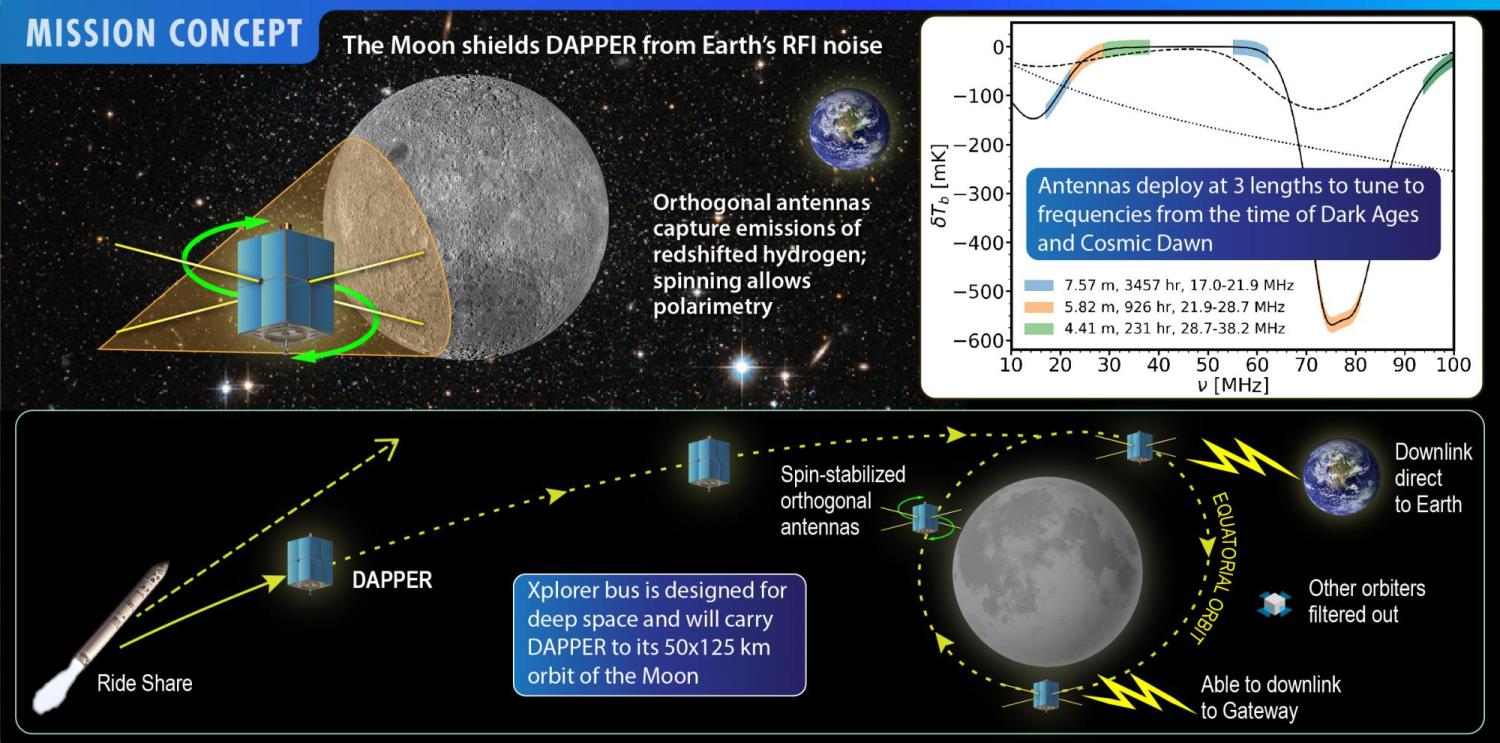
The early Universe’s Dark Ages, probed by the highly redshifted 21-cm neutral hydrogen signal, is the ideal epoch for a new rigorous test of the standard LCDM cosmological model. The Dark Ages Polarimeter PathfindER (DAPPER), operating in a low lunar orbit above the radio-quiet farside, shall search for divergences from the standard model that will indicate new physics such as heating or cooling produced by dark matter.
The main challenge of this measurement is the removal of bright foregrounds. DAPPER is designed to overcome this by utilizing two techniques: (1) a polarimeter to measure both intrinsically polarized emission and polarization induced by the anisotropic foregrounds and large antenna beam to aid in the separation of the foregrounds from the isotropic, unpolarized global signal, and (2) a pattern recognition analysis pipeline based on well-characterized training sets of foregrounds from sky observations, instrument systematics from simulations and laboratory measurements, and signals from theoretical predictions. DAPPER team members recently demonstrated the effectiveness of dynamic polarimetry to measure foregrounds using observations from the prototype Cosmic Twilight Polarimeter. Rigorous end-to-end simulations of the DAPPER instrument including thermal noise, systematics from the spectrometer/polarimeter and the beam-averaged foreground, along with 21-cm models which include added cooling meet our sensitivity requirements to separate the standard cosmological models from ones that point toward new physics. DAPPER Mission Factsheet (downloadable PDF file, 1.2 MB)
DAPPER has a highly experienced team representing a collaboration between the universities of Colorado-Boulder and California-Berkeley, the National Radio Astronomy Observatory, Bradford Space Inc., and the NASA Ames Research Center.

- Mission Concept
- The Moon shields DAPPER from Earth's RFI noise.
- Orthogonal antennas capture emissions of redshifted hydrogen; spinning allows polarimetry.
- Antennas deploy at 3 lengths to tune to frequencies from the time of Dark Ages and Cosmic Dawn.
- A rocket ride share will launch DAPPER. The Xplorer bus is designed for deep space and will carry DAPPER to its 50x125km orbit of the Moon. Spin-stablized orthogonal antennas shown along with the equatorial orbit of the Moon (other orbiters filtered out). There will be a downlink direct to Earth as well as the ability to downlink to Gateway.
- The Moon shields DAPPER from Earth's RFI noise.

- Mission Schedule
- The mission schedule will allow DAPPER to conduct observations during the construction of initial lunar infrastructure but before RFI grows too Iarge.
- Phase A-F shown along with years starting with CY20 through CY26.
- Phase A - 9 months
- Phase B - 12 months
- Phase C - 12 months
- Phase D - 16 months with launch expected towards the end of this phase in calendar year 2024
- Phase E - 26 months
- End of mission expected in the fourth quarter of calendar year 2026
